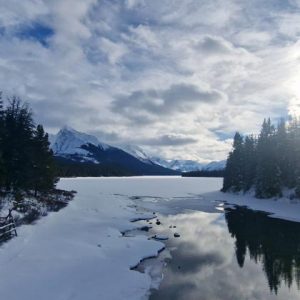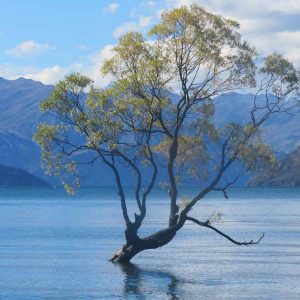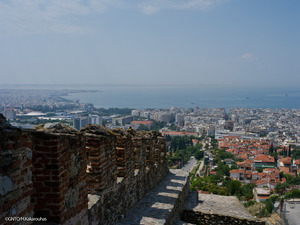 I must be honest, I’m not a great fan of fish soup however this fish soup changed my mind! A hint of garlic, a tiny sliver of chilli for heat and not a smidgeon of slime. It was fabulous, truly. And so the meal progressed, spaghetti with a tomato based fish sauce and then the simplest, most fishy sole I’ve ever eaten. All these culinary delights arrived in a taverna style restaurant, painted seaside colours, Xontro Alati, in the heart of Thessaloniki, right before entering the Modiano market, built by the Jewish engineer of the same name in the 1920s. It is undoubtedly a seriously foodie haunt, with tiny bars and cafes serving sea fresh fish and other delicacies, alongside the produce stalls.
I must be honest, I’m not a great fan of fish soup however this fish soup changed my mind! A hint of garlic, a tiny sliver of chilli for heat and not a smidgeon of slime. It was fabulous, truly. And so the meal progressed, spaghetti with a tomato based fish sauce and then the simplest, most fishy sole I’ve ever eaten. All these culinary delights arrived in a taverna style restaurant, painted seaside colours, Xontro Alati, in the heart of Thessaloniki, right before entering the Modiano market, built by the Jewish engineer of the same name in the 1920s. It is undoubtedly a seriously foodie haunt, with tiny bars and cafes serving sea fresh fish and other delicacies, alongside the produce stalls.
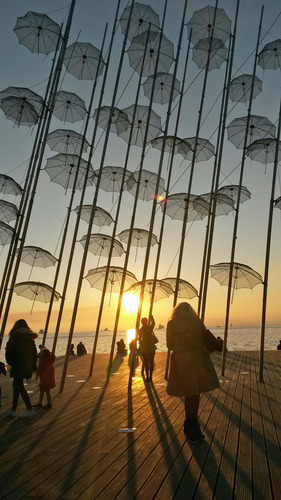 Thessaloniki takes the strapline ’Many stories, one heart’ and this absolutely reflects the city, with its history stretching way back to the 300s BC, when it was founded by King Cassander of Macedon and named after his wife, Thessalonike, Alexander the Great’s half-sister. Skip forward 350 years, St Paul arrived to preach in the city at several of the synagogues and so Christianity arrived, as recorded in the New Testament books of the Thessalonians. Three centuries later, the 53rd Roman Emperor Galerius, who administered his quarter of the Empire from Thessaloniki and built city walls, a palace, triumphal arch, hippodrome and rotunda, all still very visible, persecuted Christians and killed Demetrios, who then became patron saint of the city. His saintly relics are housed in Hagios Demetrios, which was rebuilt after the great fire of 1917, with original mosaics remaining and the most moving crypt below, is where the Saint is said to produce myrrh. Just lately, wonderfully preserved Roman baths have been excavated here too.
Thessaloniki takes the strapline ’Many stories, one heart’ and this absolutely reflects the city, with its history stretching way back to the 300s BC, when it was founded by King Cassander of Macedon and named after his wife, Thessalonike, Alexander the Great’s half-sister. Skip forward 350 years, St Paul arrived to preach in the city at several of the synagogues and so Christianity arrived, as recorded in the New Testament books of the Thessalonians. Three centuries later, the 53rd Roman Emperor Galerius, who administered his quarter of the Empire from Thessaloniki and built city walls, a palace, triumphal arch, hippodrome and rotunda, all still very visible, persecuted Christians and killed Demetrios, who then became patron saint of the city. His saintly relics are housed in Hagios Demetrios, which was rebuilt after the great fire of 1917, with original mosaics remaining and the most moving crypt below, is where the Saint is said to produce myrrh. Just lately, wonderfully preserved Roman baths have been excavated here too.
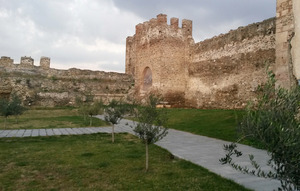 There is so much more to learn about the city and I was walked around it by the truly remarkable Constandinos Sfikas of www.hets3.com. A brilliant guide who has forgotten more than I’ll ever know! We talked about the Saracen pirates of 904AD who captured and took into slavery 20,000 inhabitants, the Norman invasion of 1185AD as well as the arrival of the Ottoman Turks in 1430AD after many different occupations by many different peoples. And one of the hidden influences of the city is that of the Sephardi Jewish population, which arrived in the 16th century from Spain and Italy. Whilst this community was decimated in World War II, Thessaloniki was at one time the largest Jewish city in the world. The Holocaust Monument of Eleftherias Square was incredibly moving and is a proud memorial to those who helped shape life here.
There is so much more to learn about the city and I was walked around it by the truly remarkable Constandinos Sfikas of www.hets3.com. A brilliant guide who has forgotten more than I’ll ever know! We talked about the Saracen pirates of 904AD who captured and took into slavery 20,000 inhabitants, the Norman invasion of 1185AD as well as the arrival of the Ottoman Turks in 1430AD after many different occupations by many different peoples. And one of the hidden influences of the city is that of the Sephardi Jewish population, which arrived in the 16th century from Spain and Italy. Whilst this community was decimated in World War II, Thessaloniki was at one time the largest Jewish city in the world. The Holocaust Monument of Eleftherias Square was incredibly moving and is a proud memorial to those who helped shape life here.
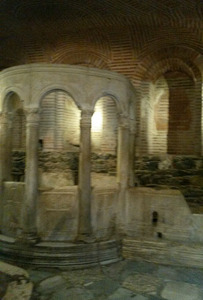 The Ottoman legacy is extraordinary, the Upper City, Ano Poli, is quite distinct from the coastal area, with a definite architecture of houses featuring the overhanging upper window and narrow streets. Right at the top of the hill are the remains of the city walls, The Trigonion Tower and the Gate of Anna Paleologina, with a stupendous view down across the entire city to the sea and the iconic White Tower. It seemed to me that once in the centre, on every corner there’s an old Haman, none in use these days in its original form. We visited the coffee shop beside Bey Hamam, where the upstairs bar leads almost directly on the cluster of doomed roofs, looking like a gathering of tortoises. Another Hamam has become a restaurant and nightclub, with no bathing area, rather a great use of space for an amazing building.
The Ottoman legacy is extraordinary, the Upper City, Ano Poli, is quite distinct from the coastal area, with a definite architecture of houses featuring the overhanging upper window and narrow streets. Right at the top of the hill are the remains of the city walls, The Trigonion Tower and the Gate of Anna Paleologina, with a stupendous view down across the entire city to the sea and the iconic White Tower. It seemed to me that once in the centre, on every corner there’s an old Haman, none in use these days in its original form. We visited the coffee shop beside Bey Hamam, where the upstairs bar leads almost directly on the cluster of doomed roofs, looking like a gathering of tortoises. Another Hamam has become a restaurant and nightclub, with no bathing area, rather a great use of space for an amazing building. 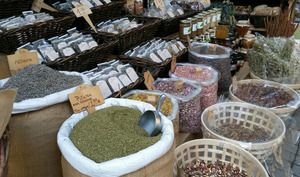 And again in the flower market area, we sat right next to another of these baths, enjoying a floral tea, in a pretty square.
And again in the flower market area, we sat right next to another of these baths, enjoying a floral tea, in a pretty square.
And this seems to be the essence of Thessaloniki, modern life taking place in a relaxed but purposeful way, amongst the most extraordinary historical monuments. Three more recent events inform the place and the people in it, four if you count the deportation of the Jews. In 1912, the Ottomans surrendered to the Greek Army and after a year of wrangling, with the Austrians and Bulgarians, in August 1913, the city joined Greece. I was proudly shown the beautiful building where this happened. It is today a ministry. Secondly, the great fire of 1917, reputedly started in a kitchen in the Upper City, destroyed a huge portion of the Jewish Quarter and central area, leading to the re-building of Thessaloniki in a modern, municipal style by the French architect, Hebrard. It is to him that the boulevards and squares can be attributed. And the third great change came when in 1923 the exchange of peoples took place between Greece and Turkey. Many of those I met had grandparents who arrived in Thessaloniki from Turkey, known politely here as Asia Minor. The city was a haven for many of these displaced Greeks and that sense of the cosmopolitan still remains. It’s easy to imagine that places such as the Kapani market, based on the Ottoman style, offered a degree of familiarity to the returnees.
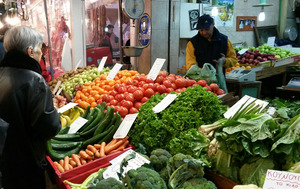 Despite the recent economic hard times, the market is bustling, filled with gorgeous produce, impeccable spice shops, superb food and my very favourite, a bakery specialising in filo pies, light as a feather. My absolute tastiest snack ever was filled with spinach, a big thank you to Toula Resiniotou, who handmakes everything. The stall of nuts and dried fruits, run by the Charilaos family, is legendary and knocks spots off Holland & Barrett! My foodie guide, Kostis Zafeirakis, would have turned me into a very large lady if I’d eaten all that was on offer. And what is indicative of this warm-hearted city is the habit of always bringing a complimentary small pastry or bowl of nibbles when you order a coffee or drink: at Cafe Palermo it was the tiniest chocolate, totally delicious.
Despite the recent economic hard times, the market is bustling, filled with gorgeous produce, impeccable spice shops, superb food and my very favourite, a bakery specialising in filo pies, light as a feather. My absolute tastiest snack ever was filled with spinach, a big thank you to Toula Resiniotou, who handmakes everything. The stall of nuts and dried fruits, run by the Charilaos family, is legendary and knocks spots off Holland & Barrett! My foodie guide, Kostis Zafeirakis, would have turned me into a very large lady if I’d eaten all that was on offer. And what is indicative of this warm-hearted city is the habit of always bringing a complimentary small pastry or bowl of nibbles when you order a coffee or drink: at Cafe Palermo it was the tiniest chocolate, totally delicious.
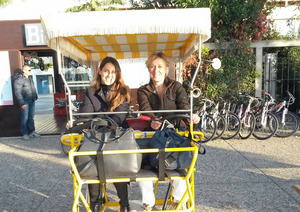 Having seen the city extensively, my lovely young companion, Evdokia, insisted on a turn along the prom! And it is spectacular, 6 kilometres from the port to the concert halls, with glorious gardens and outdoor sports facilities built alongside the wide walking area. For a slightly lazy ride, try the tandem bicycles available for hire, they take time to get used to but are a real experience and make the journey to the concert hall a gentle challenge! And the exertions gave us a fine excuse for a glass of something at one of the cafes on the way. This open space beside the sea is incredibly well used and a real bonus for the city. Overall Thessaloniki is a place for outside life, even in December we sat at pavement tables, coats on for sure, enjoying the thin winter sunshine. It’s a city designed to be out and about in, where everyone has a pair of sunglasses immediately to hand, or rather head! It is perfect to walk around, safe, open late and full of life, full of stylish people. As a single traveller, it has much to recommend it; at no time I feel awkward or conspicuous alone. Restaurants were pleasant about a table for one and there are the city walking tours to join as well. I was just as happy wandering about here as I am in London. And nearly all the under 40s spoke excellent English, which was handy when I got lost a couple of times and in the shops too.
Having seen the city extensively, my lovely young companion, Evdokia, insisted on a turn along the prom! And it is spectacular, 6 kilometres from the port to the concert halls, with glorious gardens and outdoor sports facilities built alongside the wide walking area. For a slightly lazy ride, try the tandem bicycles available for hire, they take time to get used to but are a real experience and make the journey to the concert hall a gentle challenge! And the exertions gave us a fine excuse for a glass of something at one of the cafes on the way. This open space beside the sea is incredibly well used and a real bonus for the city. Overall Thessaloniki is a place for outside life, even in December we sat at pavement tables, coats on for sure, enjoying the thin winter sunshine. It’s a city designed to be out and about in, where everyone has a pair of sunglasses immediately to hand, or rather head! It is perfect to walk around, safe, open late and full of life, full of stylish people. As a single traveller, it has much to recommend it; at no time I feel awkward or conspicuous alone. Restaurants were pleasant about a table for one and there are the city walking tours to join as well. I was just as happy wandering about here as I am in London. And nearly all the under 40s spoke excellent English, which was handy when I got lost a couple of times and in the shops too.
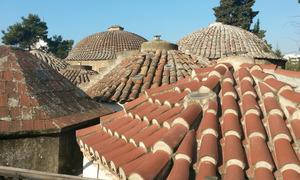 So what of the night life? Well, being of a certain age, I decided not to try the clubs, however the Olympiad near the Electra Palace was as close as I got, a combination of restaurant, bar and club. It felt very trendy, the food was good and the atmosphere great! I wheeled out my snazziest outfit, although in the event, posh jeans and a smart top would’ve worked. The Grada Nuevo, a wine restaurant, one evening stopped me in my tracks, I ran out of superlatives. It’s fish in a big way here, sumptuous fish, beautifully prepared and served. And like all eats and drinks here, incredibly well priced.
So what of the night life? Well, being of a certain age, I decided not to try the clubs, however the Olympiad near the Electra Palace was as close as I got, a combination of restaurant, bar and club. It felt very trendy, the food was good and the atmosphere great! I wheeled out my snazziest outfit, although in the event, posh jeans and a smart top would’ve worked. The Grada Nuevo, a wine restaurant, one evening stopped me in my tracks, I ran out of superlatives. It’s fish in a big way here, sumptuous fish, beautifully prepared and served. And like all eats and drinks here, incredibly well priced. 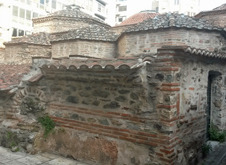 At no point did I feel ripped off; street food, coffees, elegant dinners and ice creams were very good value, and the portions generous. No blobs on a plate anywhere! Proper food all round, with a single scoop of ice cream nearly the size of an entire Haagen-Dazs tub. The Ladadika area just beside Aristotelous Square is superb to walk around, with bars and restaurants along every street, we came across a happening student party too! You could eat yourself very happy and a bit silly too amongst the windy streets and little, almost hidden piazzas.
At no point did I feel ripped off; street food, coffees, elegant dinners and ice creams were very good value, and the portions generous. No blobs on a plate anywhere! Proper food all round, with a single scoop of ice cream nearly the size of an entire Haagen-Dazs tub. The Ladadika area just beside Aristotelous Square is superb to walk around, with bars and restaurants along every street, we came across a happening student party too! You could eat yourself very happy and a bit silly too amongst the windy streets and little, almost hidden piazzas.
So Thessaloniki gets my vote most definitely! Go for history, go for food, go for the museums which are really good and most of all, go for the atmosphere – upbeat, a little eclectic and fabulously friendly. My most special memory is sitting right beside the Hellenic and Roman remains of the forum, with a glass of wine, gazing at the view down to the sea, taking in the sunset, with Mount Olympus just visible through the brilliant sky.
Jennie travelled as a guest of Ryanair who have frequent flights to Thessaloniki, at very good prices.
Read about Jennie’s hotel on this trip, the Electra Palace.


